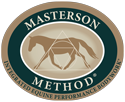Question:
After taking the University of Stanford weekend class, I have continued to learn and have fun with horse bodywork! Yesterday I worked on a 20 yr. old Quarter horse mare that has done a lot of ranch work. She is a nicely built mare with lots of Doc Bar breeding but is not the typical bulldog type. She is longer and finer. She has arthritis in her knees. Her back fetlocks are currently very rounded in front (calcification? These joints crack quite often a little as she moves). The new owner put her on Cortaflex and has seen improvement in just a week and a half. Amazingly, she has beautiful movement. Maybe because she was a ranch horse, she is pretty stoic in demeanor (at least at first).
When I started to work on her, I was surprised that she has so much lateral flexibility in her neck. There was only one area that seemed restricted. Under the scapula, down toward her chest, there was some resistance, but not what I expected from a 20 yr. old horse that has been used and not pampered. She did have trouble with the shoulder releases, although she tried. There wasn’t very much range at all when moving her front leg backwards and she could not hold it for more than a second or two. Bringing her front leg forward was easier for her, and there was a bigger range of motion, but once again, she could not comfortably hold it. She did improve while I worked with her, but I didn’t want to ask too much for the first time.
She was very touchy about her poll area. It was pretty tight on both sides plus there was a good, hard knot on her right side. I had to start off by just using hand heat until she would stand quietly. Eventually I could massage very lightly and then get firmer.
The right side of her hindquarters was pretty good. She even dropped her hip by pressing on the point. However, it was much harder for her when I actually picked up her hind foot, but not a lot of range on the right side. BUT, when I went to the left side of her hindquarters, I started getting a LOT of reaction from her. When I massaged up by her sacroiliac joint on the tuber sacrales of the croup, I got very noticeable quivering in the quadriceps muscle.
So, I hope this was right, I backed off from that area and worked around it. Is that OK? I worked on softening the other muscles. Then I went back to that area, but very softly. By the end, it was much better. I told the owner’s wife that I needed to look some things up before I went farther plus she needed to check again with her vet. Is this correct?
When I explained what we found to the owner’s husband, he mentioned that she had been through a series of ranch owners and used quite hard. He felt the last owner had overbite her way too much. He also stated that she was very nice to ride (Note: The current owner is a trainer who wanted a quiet horse for him to teach beginners on).
I am sorry that this is so long, but I really wanted to do the best I could for this mare. It was so cute because she was pretty aloof at first. There was a lot of blinking, but I got the feeling that she just couldn’t release with me standing so close. So I would work on her a little and then back away to give her some space. Then there was lots and lots of licking and chewing, sighing, heavy breathing, etc (on and on and on). After a bit, she would release and turn and look at me, as if to say, “OK, I’m ready. More!” By the end she was really trying to give me her body. The owner couldn’t believe how this old, stiff horse was swaying from one end to the other (heehee, I just love doing that!)
Answer:
It sounds like you are doing everything right with her. You’ve got her relaxing at the poll, and doing well with the lateral flexion. Regarding the down and back, if you keep her weight shifted to the opposite leg, with your body or by placing one hand on her arm above her elbow to steady her, then bring her leg just SLIGHTLY out and back – not very far, just enough to let her rest her toe on the ground comfortably, it may be easier for her to relax the muscles and release the shoulder. Also, after working on a difficult area, when you come back a second time they may often release what you were trying to get released the first time.
Regarding the hind end, the muscle quivering is nothing to worry about. The more you can get her to drop the pelvis on both sides, the better. When you pick up the foot, sometimes it helps to support the leg for a while by holding it up as if it were on the hoof stand to let everything relax, then set it slowly down (by then she will be relaxed and YOUR back will be a mess). On the left side, gently put your hand, or fingertips, on the hip point and just rest it there for a while, without pushing. Circulation will come to the area and it will start to relax. They often will start dropping the hip just from that. It will usually start to drop in little spasms. Take your time. You need to substitute time for pressure. It sounds like you were paying attention in class. Very good!
Thanks for asking, and for practicing, and for taking the clinic in the first place. Let me know if there is anything else.
